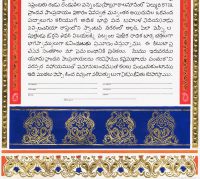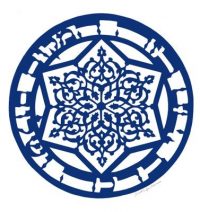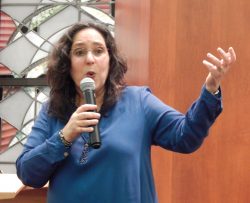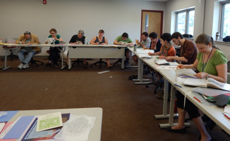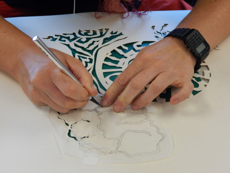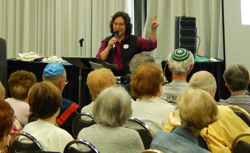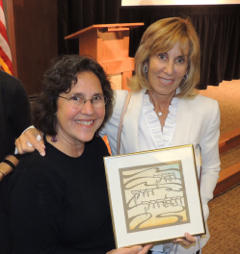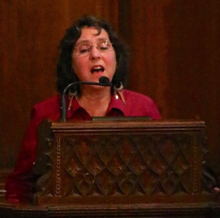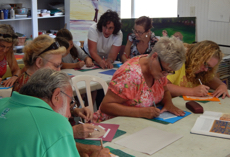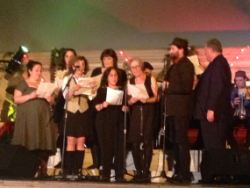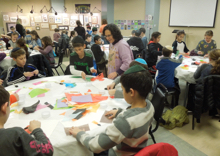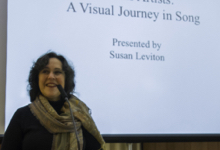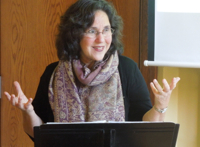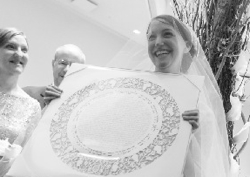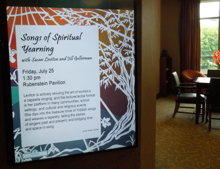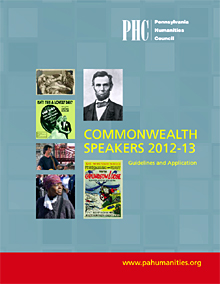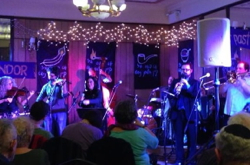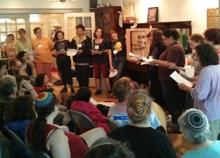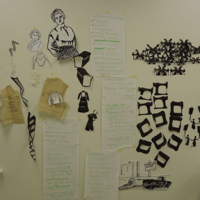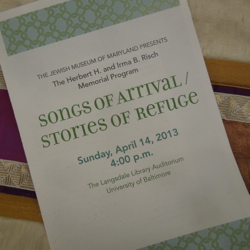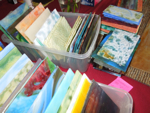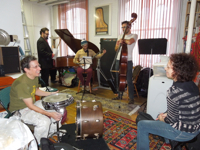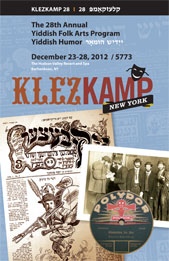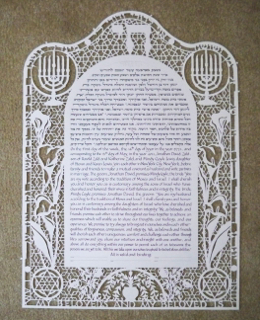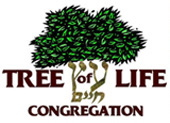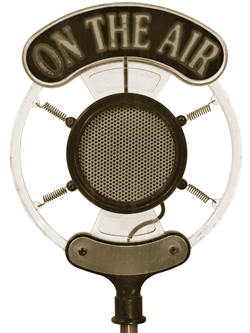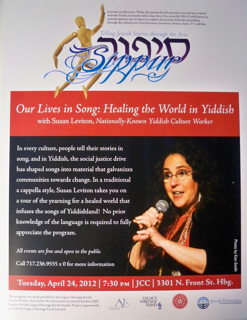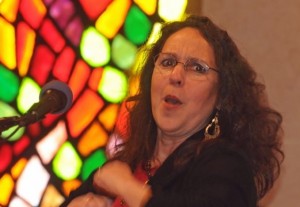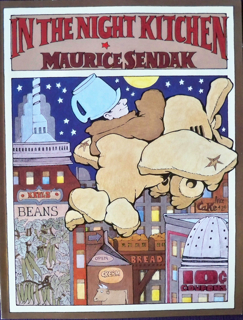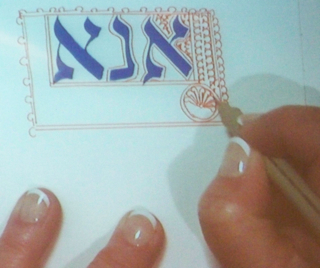What’s a ketubah?
One of the requirements of a Jewish marriage is a legal document called a ketubah, from the Hebrew root meaning ‘written.’ The traditional text is basically a 2,000 year old formula in Aramaic which is still the standard in most Orthodox and some Conservative communities, but more recently changes have been adopted by many Jews and, depending on the requirements of the officiant, the text may or may not bear any resemblance to the ancient formula.
Why are ketubot so decorative, if they’re legally binding contracts?
Since the ketubah is not considered sacred writing as are the Torah and the scrolls inside the mezuza and t’fillin cases, over many centuries it has evolved as a canvas for the expression of hiddur mitzvah – the enhancement of following a commandment by making it beautiful. As such, the ketubah has become an artistic history of where Jews have lived and which larger cultures have influenced our sensibilities. Ketubot being crafted today reflect our times just as those crafted in 18th Century Italy, for example, reflected that time and place!
There’s so much to take in! Where do we begin?
There are basically two major considerations, so let’s look at them separately: The text and the design.
How do we settle on a text?
The key here is to first ask your officiant(s) if there are requirements or restrictions. In a traditional setting, the original Aramaic text may be required, and there maybe additional requirements that govern the layout of the text body (justified left and right) and even the placement of the lines for witnesses. One consideration you may want to discuss with your officiant is the recognition of the document in Israel should you or any of your offspring consider making aliyah and living in Israel.
At the other end of the spectrum, the bride and groom may be offered the opportunity to craft their language completely, and perhaps even have their words translated into modern Hebrew – or no Hebrew! Circumstances such as intermarriage and same-sex unions dictate that the officiant be consulted in order to craft language that is appropriate and celebratory for the individual couples.
What if we write our own text, want it translated into Modern Hebrew, but lack the skill to do the translation?
The ketubah is both a legal document and and lasting memento of the celebration of a marriage. As such, the language, whether traditional or non-traditional should reflect the care with which the words are chosen. I have often had people come to me with a unique text, saying, “I have a friend from Israel who can translate this.” That may work in some circumstances, but my experience is that it is a rare individual who has the language skills to balance legalese and poetry! If you are taking time to craft your words, you will want someone equally skilled in nuance to capture not just the words, but also the intention and emotion behind them. I work with several trusted translators who may help you achieve your goals in simple, elegant Hebrew.
We are a same sex couple, or one of us is not Jewish. What are our options?
I request that you clarify your needs first with the officiant of your ceremony, and then I will be delighted to work with you to make your vision come to life. Over the years I have worked with many same-sex and multicultural couples and will be glad to offer sample texts or ideas to get you started. The tradition of illuminating (decorating) the document offers boundless opportunity to honor couples’ intertwining backgrounds.
There are a few things to keep in mind, though. In traditional Jewish life, the word ketubah specifies a contract that witnesses the marriage of two Jews. It is therefore critical that the language of the text, whether it be modern Hebrew, the traditional Aramaic, or any other language, as contemporary couples may choose with the input of the officiant, not contradict the legal terms of a contract. This also means that all the ‘data’ (names, date, place, etc.) must be correct and that the text should express a serious legal reality along with the aesthetic beauty. When working with intermarried couples who are embracing Judaism, I am careful to advise that the language of the document be scrutinized for accuracy and not imply anything that is not part of the couple’s reality.
All that said, this centuries-old format for celebrating a union in beauty offers great opportunity to focus on and then share your joy in a lasting work of art and language!
Gee, this is so interesting, but neither of us is a Jew. Can you work with us in some way?
Of course. Although in the Jewish tradition the ketubah is considered a necessary legal document, the concept of a marriage contract or document is something that any couple may design and execute. Think of what you’d like to say, not at the level of who will balance the checkbook, but at the level of a shared vision of a life together. The artistic development is wide open. I’d be delighted to use my skills and experience to help you come up with a meaningful and beautiful memento certain to become a family heirloom. (Look through the gallery of my work and you will see Quaker documents, and other pieces that reflect the realities of couples outside the Jewish world.)
Are there alternative texts we can examine?
Again, I’d start with your officiant. Over the years I have collected interesting and meaningful texts and will be happy to share them with you to get you started as well. You may also want to look at other artists’ websites for ideas, but please remember, copyright language is protected! Many times, a request for a one-time borrowing of language copyrighted by an artist will be graciously honored, so please consider this a part of your process, and don’t be afraid to ask.
Artwork! The choices seem endless! How do we start to narrow down our choices?
Yes, you may be feeling overwhelmed right now, so here’s my suggestion: Begin by thinking lightly about your initial ideas, knowing that they may change. Then look through the images on my site as well as other sites several times without editorializing, and then once again while making some notes. Don’t rule things out if they appear contradictory (e.g. “I like the circle. And I like a free-form text.”)
Consider the overall ‘look’ of the piece: traditional, bold, within a rich border, etc.
Think about your color palette, but please don’t try to match your sofa! Your sofa will wear out and your taste may change. Start with broad ideas like bold, soft, leaning towards blues, etc.
List the meaningful touches you may want to incorporate: a reference to where you met, the meaning of your names, any children who will be blended into your family, seasonal references, etc.
Embellishments like papercuts, gold leaf, embossing, etc.
Then the weeding work begins.
How do we proceed once we have our ‘shopping list?’
I may spend hours talking with you – or minutes! One groom called me while standing on a subway platform and in 2 minutes told me everything I needed to know in order to craft their ketubah! But this was highly unusual!!
Generally I will talk with you by phone several times, perhaps Skype, and exchange ideas until I feel I have enough information to envision your ketubah. The delight of Skype is that I can sketch as we talk and hold images up for you to see as we would do if we were sitting in the same room. Distance is no issue. And I will continue to ask you questions to help focus on the aesthetic whole that will become your ketubah.
We have a dear family friend who is an artist and would like to give us the gift of painting the ketubah border. Is this a possibility?
I have had collaborative experiences that are win-win, and some that are somewhat stress-producing. I will be most happy to engage in conversations with your artist to explore the possibility of my lettering blending with another person’s artwork. I would not rule anything out, but this process generally requires more lead time to allow for exchange of paper samples and templates, and extra shipping time, all while allowing each of us to work without the stress of an early deadline.
What other specific information will we need to provide?
Depending on the text, there will be some formulaic information needed to complete the text. I will certainly need your complete Hebrew names and the date and place of the wedding. If there are questions about your names, I can try to help, but the best places to start are with your family, your officiant, and perhaps consulting documents such as a brit certificate or bar/bat mitzvah certificate if you are unsure of spellings of Hebrew names. If there is no Hebrew name, please consult your officiant or put me in touch with that person to determine how to represent the name in Hebrew letters, as appropriate.
I will also need to know how many signators there will be. Traditionally, two witnesses sign the ketubah, but in consultation with your officiant you may determine that you’d like additional witnesses, that the two of you wish to sign (especially if you write an English text in the first person plural), and that you’d like your officiant(s) to sign.
Can the whole document be in English?
Again, a question to bring up with your officiant. I have crafted many ketubot where an introductory paragraph is in Hebrew and then the balance of the text is in English – or the reverse. We are living is a wondrous time for creative and meaningful Jewish art!
How is cost determined?
Most ketubot will take from 10 to 45 hours to craft, and the cost determinants are the length of the text(s), complexity of the layout, and intricacy of design. My range is from approximately $800 (hand-lettered text and most simple embellishment) to $4,000 and up. I ask that you consider your budget range as you are considering your wish list. Then we’ll talk and it will be my job to bring those two together for you. Sometimes simply the use of color in the lettering is enough to create true beauty while keeping within a tight budget.
How will the ketubah be shipped and what if we want to display it at our reception?
I ship the documents flat (UPS) in a sturdy folder, with acetate covering the artwork. The document will arrive slipped into corners where it will stay safe until it’s ready to be framed. The folder may be opened and the acetate lifted for signing. Then the entire piece may be read at the huppah and displayed on a easel at your reception if you wish. Please appoint a ketubah-watcher to carry it from the huppah and to be certain it reaches the right destination at the conclusion of your wedding celebration!
How much time should we allow for this process?
Ideally, I’d like 3 months from the time that final decisions are made, but I understand that circumstances are not always ideal. I will do my best to work within your time frame, but as we get very close to a wedding date there may be rush charges incurred. The initial part of the process should be begun as soon as possible: determining your text and making sure you have accurate information about your Hebrew names. You’d be surprised at how many people find out in the middle of ketubah planning that a father is a Levi, that an assumed name is not the birth name assigned, or that a very familiar name is actually not one’s Hebrew name!
Can we be assured that the text will be accurate?
Everything is proofread at least once by another reader before leaving my studio. I guarantee that what you provide to me will be what you receive on your final document. If your officiant wishes to see the text before I release it, that will be fine. I’m happy to scan and send an image of the text to that person for approval, too.
We’re so curious about the process. Will it be possible to see the work evolve?
If you’d like, I can email images of the work in progress.
This will be a lasting work of art. Is there a way we can have smaller copies to frame for our parents as mementos?
I work with a fine imaging center that creates Giclee prints, and if you desire, I can have fine-art (archival) prints made on watercolor paper in colors true to the original for you. Please let me know if this is something you’d like to consider so I can plan for the few days that will require.
What about payment?
Upon agreement of cost, I will request a percentage deposit as check, cash, money order, or through PayPal. The balance will be billed upon completion and must be received prior to shipping the ketubah.
What about ‘care and feeding’ of the ketubah?
I work with only the finest materials – acid free papers, permanent Sumi ink, high quality paints. In most cases painting is done with water-based paints, and the application of gold leaf makes it imperative that a mat separate the glass from the surface of the artwork. I highly recommend acid free mats and backing to protect the paper.
In addition, at signing, please place a clean sheet of paper under the hands of the signators to keep oils and sweat off the document. Signing should be done in ‘document-safe’ ink, which means the ink will not fade. Many ball point pens with black ink will do, but I generally recommend a Micron or Accurit pen which will not fade and which needs very little pressure on the paper. Avoid other felt-tip pens because they may feather and the definitely will fade. (Pens that claim to be permanent contain ink that will never wash out of your clothes but will vanish over time when exposed to light. Your favorite Sharpie marker is a prime example of that. Unless your specify otherwise, I will enclose a pen with the ketubah when it ships.
We purchased a ketubah print (or were given one as a gift). Do you fill in other artists’ ketubot?
Yes, of course. Since I’ve been honing my skills for so many years, I take pride in being able to match style, letter height and weight so your completed ketubah will look like it was written by one person, start to finish. You will need to provide me with the exact information I’ll need to complete the ketubah. I will ship the completed ketubah back to you the same way you send it to me, e.g. in a mailing tube or flat. We can discuss the cost of that work which varies slightly depending how much prep is needed for different paper surfaces and layouts.



